Photos with this report (click to enlarge) | |||
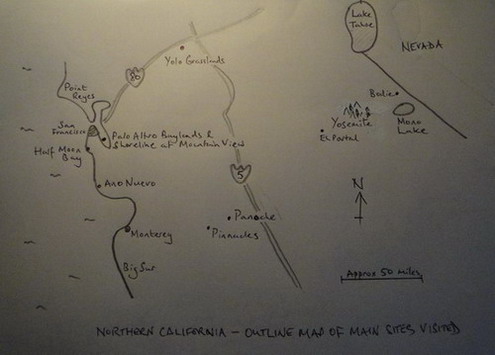 Map of main sites visited |
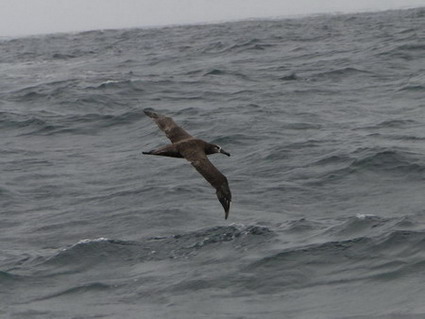 Black-footed Albatross |
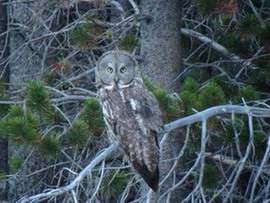 Great Grey Owl |
|
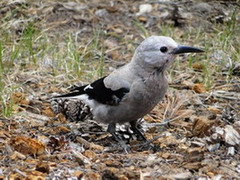 Clark's Nutcracker |
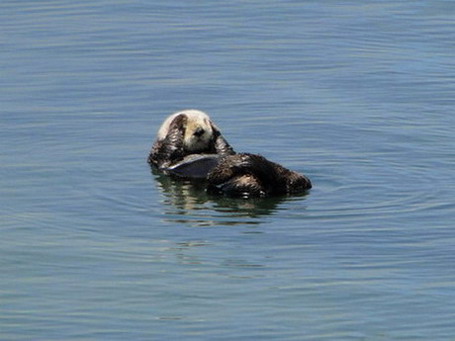 Sea Otter |
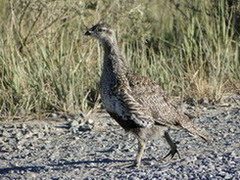 Sage Grouse |
|
Introduction
This report outlines a two-week family trip to California, undertaken by Pete Aley, Alison Rowntree and Jake Aley (age 16) – all birders and wildlife enthusiasts.
We were keen to see and photograph a good selection of birds and mammals without being in too much of a rush or travelling vast distances. The itinerary was designed with this in mind, rather than “ticking off” everything. For a rough map of sites visited – see photos.
We relied heavily on Kemper’s Birding Northern California (2001) which proved remarkably accurate and informative. A few bird reports and information from friends who have visited the area, supplemented this. Where not given in this report, directions to sites can be found in Kemper. It also contains a useful section on hazards (n.b. Poison Oak).
We organised the trip ourselves, over the internet, pre-booking: all accommodation (after checking Trip Advisor); a hire car (mid-size SUV); and a pelagic trip (see below).
We found California an excellent place for a birding holiday, with a varied habitat and plenty of wildlife in a relatively small area.
For further details contact me – peteraley@msn.com
16th July - Mill Valley
After an 11 hour flight, we arrived at San Francisco Airport, picked up our hire car and drove north to the Golden Gate Bridge. Here we encountered our first of many Brewer’s Blackbirds, Western Gulls and Brown Pelicans. In rather British-like cool, misty and breezy conditions, we continued to Mill Valley (c30 mins drive from the airport) and checked into America’s Best Value Inn. Situated in Tamalpais Valley, a few miles from downtown, beside some marshland, here we found roosting wader flocks including Willets (30+), Least Sandpipers (c20) and a few obliging Long-billed Curlews. Singles of Western Grebe, White-tailed Kite, Great White Egret, Song Sparrow and Turkey Vulture, plus Snowy Egrets (3) completed the introduction to Californian birding (the latter four species were to prove widespread during the trip).
17th July – Point Reyes
We drove to Point Reyes, an area of varied habitat including coastal prairie, lagoons and rocky shores (less than an hour North West of Mill Valley) and started at the Bird Observatory where unfortunately, the weather remained poor, so no ringing was taking place. However we walked the (Fern Canyon) trail from the car park and found a Spotted Towhee, a few Wilson’s and Orange-crowned Warblers, a Crossbill, Purple Finches (4), Wrentits (2), Chestnut-backed Chickadees (15), single Pacific-slope and Olive-sided Flycatchers, and the first of many Cliff Swallows, Steller’s Jays and Black Phoebes. Three Allen’s Hummingbirds were around the Observatory.
In improving weather, next we headed for the “Outer Peninsula” checking for owls in the groups of isolated trees beside each historic ranch. This soon reaped rewards with a Great Horned Owl at Historic Ranch B. These birds can sit in remarkably prominent positions during the day, so are worth scanning the trees for. Amongst the Red-shouldered Blackbirds we found a single Tri-coloured. Moving on to the lighthouse we found a Rock Wren, Pigeon Guillemots and Brandt’s Cormorants.
Finally we visited Chimney Rock where we discovered two more Great Horned Owls and a Barn Owl in trees below the car park. White-crowned Sparrows showed well and we found Western Grebes (6) and Pacific Divers (2) on the sea, and Elephant Seals on the beach (there is a viewing area for the latter). A few Harbour Porpoises passed by and our first Heerman’s Gulls were seen at distance.
We checked into Motel Inverness at Inverness – a fantastic location overlooking marshland, with a boardwalk, bird feeders and lots of information about the local wildlife. During the evening here, sightings included Anna’s Hummingbirds, Downy and Acorn Woodpeckers, Belted Kingfisher, plenty of Violet-green Swallows, an American White Pelican, a Grey Fox, a Racoon, and our first of many California Quail (family party).
18th July - Point Reyes and Yolo Grasslands
Early in the morning we went in search of Bobcat, driving the Pierce Point Road towards Tomales Point and then walked towards the point from the final car park. Although we were unsuccessful, consolation came in the form of Grasshopper and Savannah Sparrows, Pelagic Cormorants, a Northern Harrier, a Cooper’s Hawk and another Great Horned Owl (at Historic Ranch H), Western Bluebirds (10), a distant whale (Humpback or Grey), a Long-tailed Weasel and lots of Tule Elk.
Next we visited Tomales State Park and tried the first Spotted Owl site mentioned by Kemper but found little other than Pacific-slope Flycatchers and Wrentits, plus our first California Gull.
We then set off East for Yolo County Grasslands Regional Park – an area of inland farmland and grassland near Davis - to look for Burrowing Owls. This should have been a two-hour drive but took three hours due to heavy traffic around the North side of San Francisco Bay. This area however, held some big flocks of waders including Black-winged Stilts and American Avocets; also en-route we saw a White-tailed Kite, more Northern Harriers and a Band-tailed Pigeon.
Despite finding the Burrowing Owl site (and the sign) described by Kemper, we saw no owls and departed early evening with Yellow-billed Magpies, Swainson’s Hawks and a Northern Mockingbird added to our tally.
Night spent in Best Western, Roseville (c30 mins from Yolo Grasslands).
19th July - Lake Tahoe
After a two-hour drive East, we arrived at the North end of Lake Tahoe - a huge expanse of fresh water surrounded by conifers – and drove down the West shore. There were however, few places to stop and we saw little before arriving at Lake Tahoe Visitor Centre at the South end. Here we birded both the Rainbow and Lake of the Sky trails during late afternoon, seeing Hairy Woodpecker, Mountain Chickadees (the first of many), several Yellow-rumped and Yellow Warblers and a stunning male Western Tanager.
Night spent in America’s Best Value Inn, South Lake Tahoe.
20th July – Lake Tahoe and Mono Lake
Several hours pre-breakfast birding on the Fallen Leaf Lake trail (just South of the Visitor Centre) proved excellent with our only Black-headed Grosbeak and White-headed Woodpeckers (2) of the trip, plus Red-breasted Nuthatches (4), Williamson’s Sapsuckers (2), more Yellow-rumped Warblers and a Brown Creeper.
Next we headed South to Virginia Creek Settlement (two hours away) via a bit of Nevada and with a quick stop at Topaz Lake. The latter produced little other than Western Grebes, but other sightings en-route included White-faced Ibis (2), Swainson’s Hawk (1) and a Black-billed Magpie.
During the afternoon we spent some time around our accommodation for the next three nights – Virginia Creek Settlement (near Bridgeport) – well placed virtually opposite the road to Bodie, close to Mono Lake, within striking distance of Yosemite, and beside a stream. Here we saw a Red-shouldered Hawk, a Black-throated Grey Warbler and a Muskrat – all the only sightings of the trip.
An early evening trip to the boardwalk at Mono Lake Country Park produced a handful of American Avocets, single Spotted Sandpiper and Wilson’s Phalarope, plenty of California Gulls and Violet-green Swallows, Marsh Wrens (4) a few Yellow Warblers.
21st July – Bodie and Mono Lake
Up for first light, we drove the road towards Bodie (an historic ghost town c30 mins East of our accommodation, which opened at 9am not 8am as stated in Kemper). This area proved excellent, highlights being a brief view of a Black Bear (from where the road becomes a dirt track), a few Coyotes, and no less than 45 Sage Grouse which showed well very close to Bodie, on and beside the track. Other sightings included Green-tailed Towhees (4), Sage Thrashers (8), some Brewer’s Sparrows, and a Northern Harrier.
On the track which leads South from Bodie towards Mono Lake we found a few Clark’s Nutcrackers and Rock Wrens and Mountain Bluebirds, plus a stunning Golden Eagle on the track just in front of the car. Further down this track around where it meets the road overlooking Mono Lake we encountered Say’s Phoebes (3) and Pinyon Jays (c15), the latter flying in from the direction of the Lake at around 8.30am.
We took an interesting tour around Bodie where American Kestrels and nesting Cliff Swallows were a bonus.
An evening trip to Mono Lake produced thousands of Wilson’s Phalaropes (at both South Tufa) and the Country Park boardwalk, with just one Red-necked amongst the latter, and at South Tufa, a Clark’s Grebe, Killdeers (4) and some Least Sandpipers.
22nd July – Yosemite & Bodie
We headed for Yosemite National Park, an area of stunning mountainous scenery, forest and meadows. Following a brief stop just after the East Gate, where plenty of Yellow-rumped Warblers and two Clark’s Nutcrackers showed, we headed for White Wolf campground (c1 hour, 15 mins from our accommodation) seeing a Yellow-bellied Marmot on the way.
We found Williamson’s Sapsuckers (2) beside the approach road c1 km before the camp), plus Golden-crowned Kinglets (4) and Hermit Warblers (5) both around the camp. We then followed the track/trail from here to Harden Lake, returning via the trail loop slightly to the East - c8 miles in total. (There are many trails in Yosemite and although not to British OS standard, you can choose and follow these using a detailed map such as the one which we used - Wilderness Press Yosemite Park and Vicinity 1:125,000).
Beside the track to the lake we chanced on a superb male Pine Grosbeak before finding an adult Black-backed Woodpecker feeding a juvenile on a tree where the trail meets the lake. The lake held Buffleheads (7) and as we headed off we saw two Chipping Sparrows. As we followed the trail a bit further we had several brief views of what was probably a Great Grey Owl but despite extensive searching, couldn’t clinch it.
After returning to our accommodation, we took an evening drive along the road to Bodie. A dozen Common Nighthawks performed beside the road and just before dusk four Sage Grouse showed on the track very near Bodie. As we returned in the dark we found four Common Poorwills on the track, eyes glinting in the head lights, and a Short-eared Owl perched on a roadside post.
23rd July - Yosemite
Today started earlier than we expected with a noise outside our room just after midnight waking Alison who quickly alerted the rest of the family to a huge Black Bear rummaging through the bin! Although it got scared off by the slightest noise, it reappeared several times during the night, at one point poking its head though the bar on the balcony just a couple of metres from us – a fantastic encounter with this formidable creature!
Despite the interrupted night’s sleep, we made an early start at Lee Vining Canyon (c40 mins drive en-route to Yosemite) where the highlights were an American Dusky Flycatcher, an Orange-crowned Warbler, Western Tanagers (3), and a Red-breasted Nuthatch.
Following this we returned to Yosemite where a single Cassin’s Finch appeared just after the East entrance and we walked to Dog Lake (trail head c8 miles from East entrance - c3 miles return walk) where we saw Warbling Vireos (2), a Swainson’s Thrush, a Lincoln’s Sparrow, a male Cassin’s Finch and a very tame Clark’s Nutcracker.
We then visited Tuloume Grove (entrance half mile East of Crane Flat on Tioga road; 2.5 mile round walk) to see the Giant Sequoias, the heaviest living things on earth – few birds of note.
After checking into our accommodation for the next two nights (a Cedar Lodge chalet 2.5 miles West of the main motel, near El Portal, just West of Yosemite) we saw a Belted Kingfisher over the river and enjoyed a Great Horned Owl in tree tops at dusk.
24th July – Yosemite
An early morning search of Chevron Meadow (by Crane Flat, c40 mins drive from our accommodation) produced no Great Grey Owl but (at the meadow on the North side of the Tioga Road) we watched our only Pileated Woodpecker of the trip and several Lincoln’s Sparrows. We then drove towards Glacier Point (c1 hour, 30 mins) where we watched a McGillivray’s Warbler beside the car park before enjoying great views and a White-throated Swift. A few hundred meters back up the road (where a trail crosses the road) we found a very tame Blue Grouse with three young, to complete the morning’s birding, before returning to our chalet where five Lesser Goldfinches showed.
In the evening we headed for McGurk Meadow (50 mins from our chalet and a 0.7 mile trail from the road). Here, at 19.50 we saw what we wanted - a superb Great Grey Owl which appeared from the trees where the trail from the road joins the meadow. It perched on a pile of branches and then worked its way around the edge of meadow sitting intermittently on branches in the open and, at one point, landing in the grass. We had great views of this obliging bird until we left at 20.15.
25th July – El Portal & Panoche
A short walk along the Merced River near our accommodation revealed an American Dipper, Bushtits (4), Ruby-crowned Kinglets (2) and California Towhees (2) before we took the three-hour drive West to Panoche Valley, a remote desert-like area, where our main quarry was Roadrunner.
En route we made several short stops at the San Luis Refuge (a wetland area mainly dried up at this time of year) where highlights were: some flocks of White-faced Ibis flying over, American Bitterns (2), an American White Pelican, a Hairy Woodpecker and a Purple Finch.
At Panoche we drove along Little Panoche Road, making frequent stops, and encountered Lark Sparrows and Shore Larks in good numbers, plus Western Kingbirds, Ashy-throated Flycatchers (2), Killdeers (6) and Rock Wrens (2). Next we drove New Idria Road which produced more Lark Sparrows, a Prairie Falcon and, in the canyon, California Towhees (2) as well as several hundred California Quail. And finally, just after the canyon, as we were beginning to give up hope, we came across a charismatic Greater Roadrunner in a field of shortish dried up grass beside the road.
Night spent in Best Western, Hollister (c1 hour from New Idria Road).
26th July – Pinnacles & Monterey
We drove (c45 mins) to Pinnacles National Monument, an area of cliffs and woodland. On the approach road to the park, we came across a party of Wild Turkeys, a flock of Oak Titmice (50), Lawrence’s Goldfinches (10+) and California Thrashers (2). The latter two species were in oaks on the left hand side of the road (opposite a shallow “canyon” with little vegetation, on the other side of road), about 0.5-1km from the visitor centre turn off.
Sightings around the visitor centre and campground included single Ash-throated Flycatcher, Bewick’s Wren, Western Tanager and White-breasted Nuthatch, plus some Western Bluebirds. As we left, we spotted a Prairie Falcon on a telegraph pole beside the road before driving (c1 hour, 30 mins) to Monterey on the coast.
A look from Municipal Wharf in Monterey Bay and then from various spots along the Northern peninsula (Pinos Point) produced some endearing Sea Otters, California Sea Lions, Harbour Seals, Black Oystercatchers (2), Black Turnstones (6) and a few Pigeon Guillemots.
Night spent in Motel 6, Monterey.
27th July – Big Sur & Moss Landing
We drove towards Big Sur, an area of attractive rocky coast line and limited woodland. Scanning the sea from one of the vantage points en-route, we watched at least five Humpback Whales, blowing splashing and occasionally showing their distinctive tails – a fantastic sight! At Andrew Molera State Park we discovered that the ringing station mentioned in Kemper has closed, but walked the trail from the car park, via the campsite (North of the river) then waded across the river mouth and returned on the path South of the river. Purple Martins(8) appeared overhead and in the wood – Bushtits, Wrentits (2), Ruby-crowned Kinglets (2), Orange-crowned (1) and Wilson’s (6) Warblers, Downy Woodpeckers (4), Pacific-slope Flycatcher (1), Warbling Vireos (2), California and Spotted Towhees and plenty of Chestnut-backed Chickadees. The beach produced a Black Oystercatcher and on the sea, we came across a Surf Scoter and two Black-necked Grebes.
We set off north for Half Moon Bay (c2 hours, 30 mins), stopping at Moss Landing (lagoons and an inlet, 18 miles North of Monterey - turn West just North of where Route 1 crosses the river – marked for state beach – and follow the sandy track to a car park, checking for birds on way). This area proved fantastic with some good flocks of waders and terns and superb views of a gathering of 60 Sea Otters, plus a party of California Sea Lions. In addition to flocks of Least Sandpipers and Marbled Godwits (50), we found Long-billed Curlews (2), Willets, Western Sandpipers (2) and Kentish Plovers (2). Elegant and Caspian Terns gathered on a sandbank and we encountered Ruddy Ducks (3), Double-crested Cormorants (6) and a Pacific Diver.
Night spent in Oceano Hotel & Spa, Half Moon Bay.
28th July – Pelagic
We set off from Half Moon Bay on a pelagic trip booked with Shearwater Journeys. Despite the trip spending little time in deep waters due to the weather conditions (which were “normal” by British pelagic standards!) and no large flocks of sea birds being found, we did see small numbers of a range of species.
Highlights were a Black-footed Albatross which lingered around the boat for about five minutes, good views of shy Marbled Murrelets (4) and localised Ashy Storm Petrels (8), and a Leatherback Turtle close to the boat. These were complimented by plenty of Grey Phalaropes and one Red-necked, flocks of Cassin’s Auklets, Rhinoceros Auklets (4), a constant trickle of Sooty and four Pink-footed Shearwaters, Pomarine (2), Arctic (2) and Long-tailed (1) Skuas, and a dozen Elegant Terns.
In and around the harbour, we finished off with Surf Scoters (12), Great Northern, Pacific and Red-throated Divers, Hudsonian Whimbrels (4), Black Oystercatchers (3), a Wandering Tattler, Black Turnstones (2) and Surfbirds (2).
Night spent in Oceano Hotel & Spa, Half Moon Bay.
29th July – Palo Altro Baylands and Shoreline at Mountain View
Having dipped the first time, today’s main focus was to try and see Burrowing Owl. We drove (c40 mins) inland to two neighbouring country park-type sites beside San Francisco Bay. Starting at Palo Altro Baylands, we watched a good flock of waders on the rising tide near the visitor centre (which was closed) including plenty of American Avocets, Least Sandpipers and Black-winged Stilts, a dozen Greater Yellowlegs, two Semi-palmated Sandpipers, a Hudsonian Whimberel and nearby, a Long-billed Curlew and Ruddy Ducks (12).
Moving on to Shoreline at Mountain View in the early afternoon, we first visited the Burrowing Owl habitat opposite the golf course, to familiarise ourselves for later. The Bay here held plenty of Forster’s Terns, American White Pelicans (12), and two distant Black Skimmers on an island. A visit to the water sports centre (“Shoreline Lake”) produced more Forster’s Terns, and Black Skimmers (10) plus American Coots (3) – Jake’s kayak trip produced close views of these!
Early evening saw us return for owls and this time at 6.45pm, there they were – three fantastic Burrowing Owls (two adults and a juvenile) looking quizzically from beside their burrow! There are many promising looking earth mounds with artificial and natural burrows in this area. The one we saw the owls on can be accessed from the car park for the kite-flying park which is between the entrance gate and the golf course car park. Walk from here a short way down the road (North) towards the golf course car park and water sports centre and almost immediately turn right (East) on a broad track for a few hundred meters to a hollow (with four posts arranged in a rectangle, in it). Bear right around this hollow to view the (only) earth mound, looking back towards where you have come from. There are two big logs on their side, which is a good place to view from. (This area is South of a sign, about the owls, by a path overlooking the Bay). These birds are now very scarce in Northern California and it’s important not to stray from the tracks and disturb them.
In this area we also saw - Northern Mockingbird (1), Western Bluebirds (4), California Towhees (3), Grasshopper Sparrows (4); and as we left the site on route 101, a White-tailed Kite flew over.
Night spent in America’s Best Value Inn, Watsonville (c 1 hour, 20 mins drive).
30th July – Ano Nuevo State Reserve
For our final day of wildlife watching, we drove (c1 hour) up the coast to Ano Nuevo, a shoreline reserve with coastal scrub. Here the main attraction is the impressive gathering of Elephant Seals which performed well for us splashing and fighting as well as lounging around on the beach. Birds seen included - Marbled Murrelets (4), Pigeon Guillemots (3), Brandt’s & Double-crested Cormorants, Northern Harriers (3), Cooper’s Hawk (1), Chestnut-backed Chickadees (2), Lincoln’s Sparrows (2), Spotted Towhees (2), Wrentits (2) and Bushtits.
We then drove to San Francisco Airport (c1 hour, 10 mins), dropped the hire car off and took the light rail to down town San Francisco.
Next three nights spent in Stratford Hotel, Powell Street, San Francisco.
31st July to 2nd August – San Francisco
Although principally sight-seeing, we encountered a bit of wildlife including – California Sea Lions (Pier 39, Fisherman’s Wharf), feral Red-masked Parakeets (Telegraph Hill), and some Elegant Terns over the Bay.